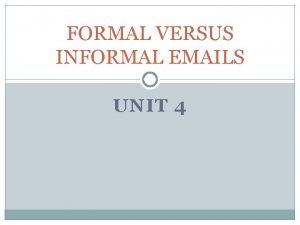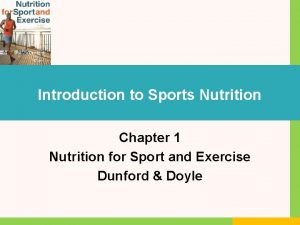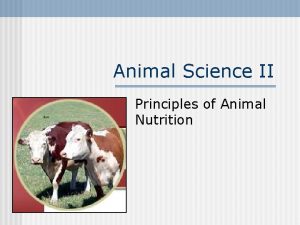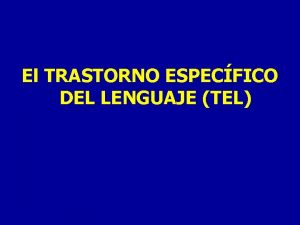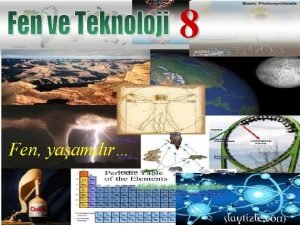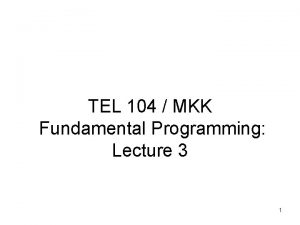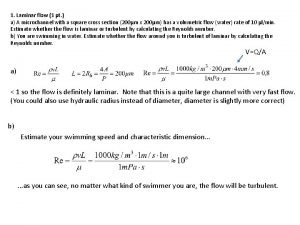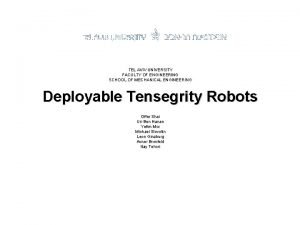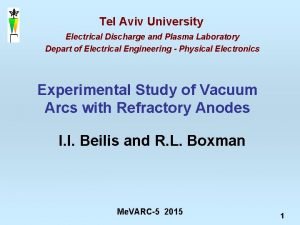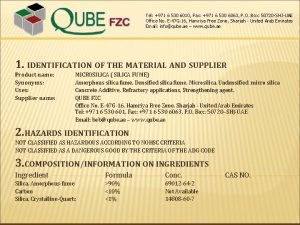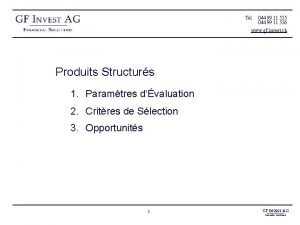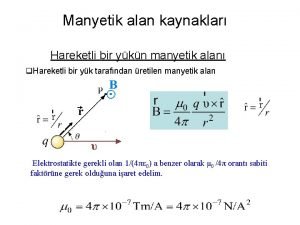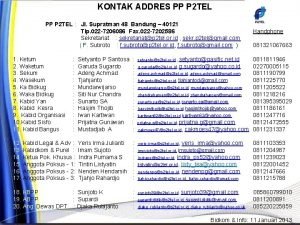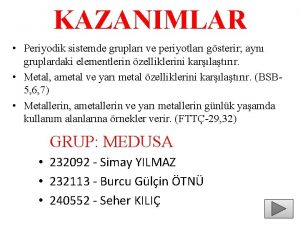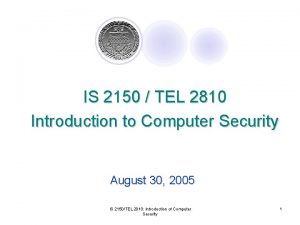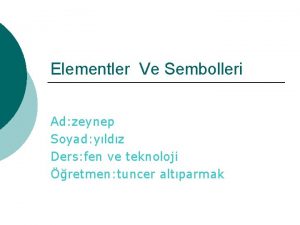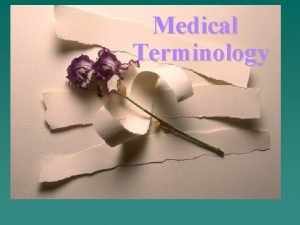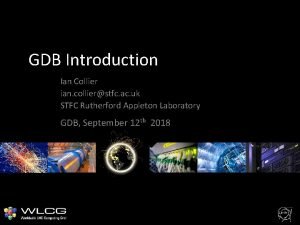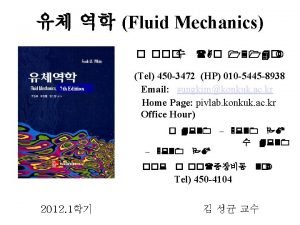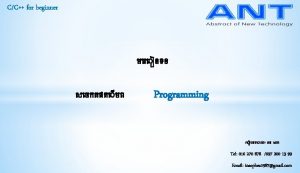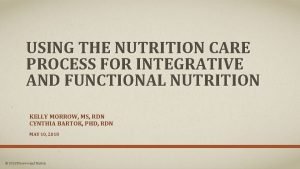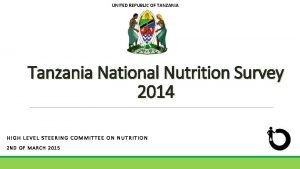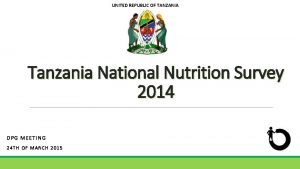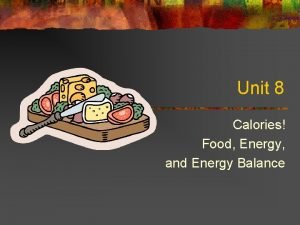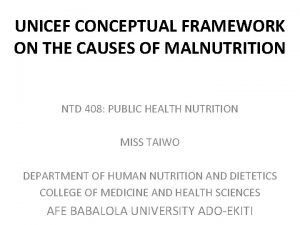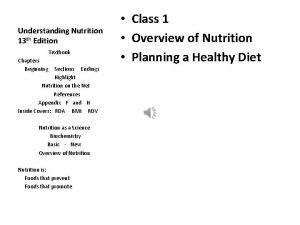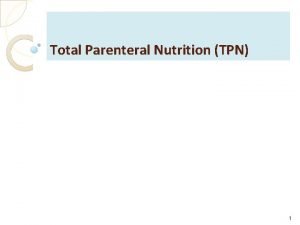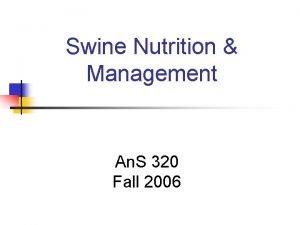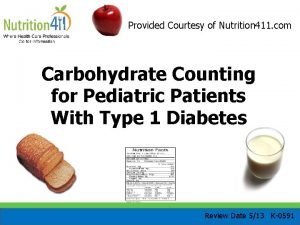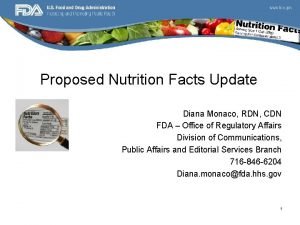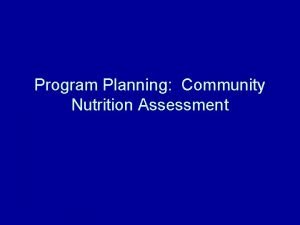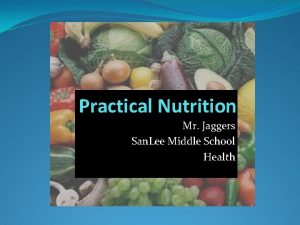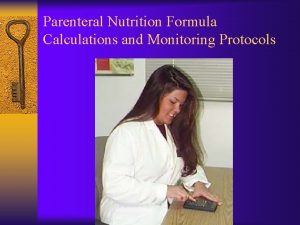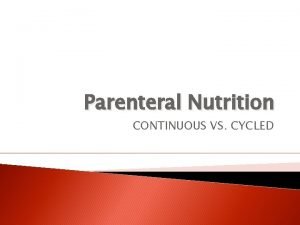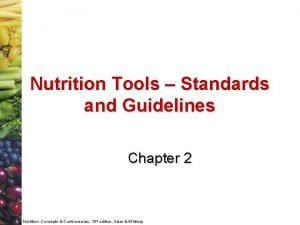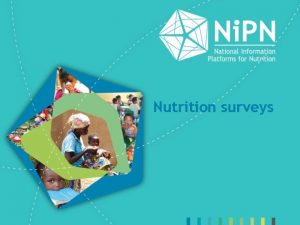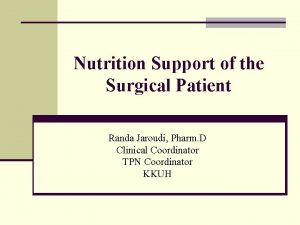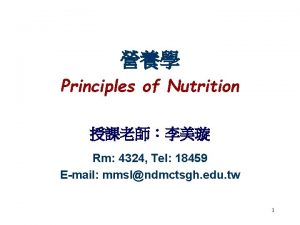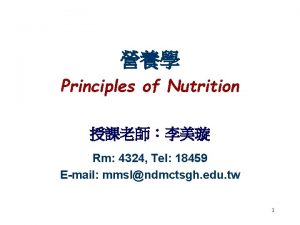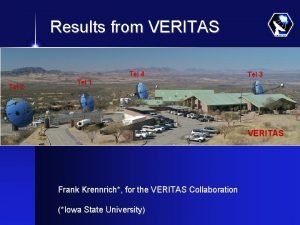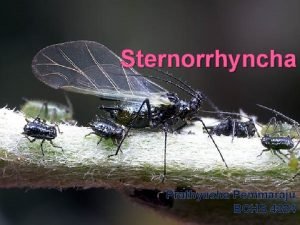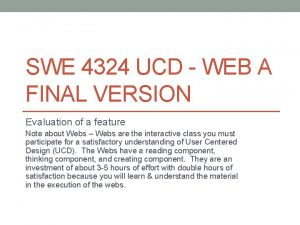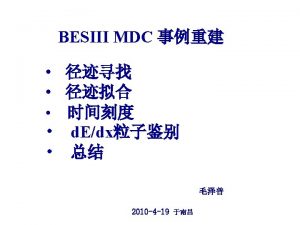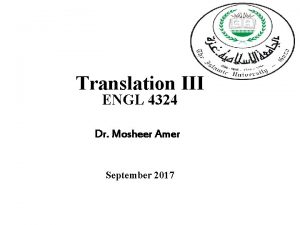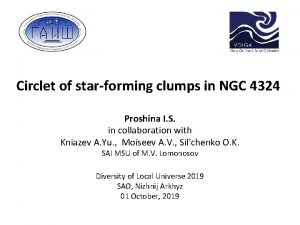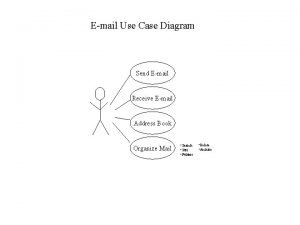Principles of Nutrition Rm 4324 Tel 18459 Email


































































- Slides: 66

營養學 Principles of Nutrition 授課老師:李美璇 Rm: 4324, Tel: 18459 E-mail: mmsl@ndmctsgh. edu. tw 1



Presentation copyright © 2001 David A Bender Why Eat ? I eat because I am hungry Why are you hungry ? I am hungry because I have not eaten 4

Why eat? • metabolic fuels (energy sources) • amino acids for protein turnover • vitamins and minerals to replace losses 5

Factors affecting food choices • Availability of foods • Cost of foods • Time for preparation and consumption • Disability and infirmity • Personal likes and dislikes • Intolerance or allergy • Eating alone or in company • Marketing pressure and advertising • Religious and ethical taboos • Perceived or real health benefits and risks • Modified diet for control of disease • Illness or medication 6

Take a good look at the diet of each country and the cost of what is eaten in one week From: Peter Menzel, Faith D'Aluisio (2005) Hungry Planet: What the World Eats 7

Germany: The Melander family of Bargteheide Food expenditure for one week: 375. 39 Euros or $500. 07 8

United States: The Revis family of North Carolina Food expenditure for one week $341. 98 9

Italy: The Manzo family of Sicily Food expenditure for one week: 214. 36 Euros or $260. 11 10

Mexico: The Casales family of Cuernavaca Food expenditure for one week: 1, 862. 78 Mexican Pesos or $189. 09 11

Poland: The Sobczynscy family of Konstancin-Jeziorna Food expenditure for one week: 582. 48 Zlotys or $151. 27 12

Egypt: The Ahmed family of Cairo Food expenditure for one week: 387. 85 Egyptian Pounds or $68. 53 13

Ecuador: The Ayme family of Tingo Food expenditure for one week: $31. 55 14

Bhutan: The Namgay family of Shingkhey Village Food expenditure for one week: 224. 93 ngultrum or $5. 03 15

Chad: The Aboubakar family of Breidjing Camp Food expenditure for one week: 685 CFA Francs or $1. 23 16




NUTRITION “Is the science of foods, the nutrients & other substances therein; their action, interaction, & balance in relationship to health & disease; the processes by the organism ingests, digests, absorbs, transports, & utilizes nutrients & disposes of their products. In addition, nutrition must be concerned with social, economic, cultural, & psychological implications of food & eating. ” 20


The Nutrients 1) Macro (巨量) nutrients: Protein, Fat, CHO 2) Micro (微量) nutrients: Vitamins, Minerals 3) Essential (必需) nutrients: 身體不可或缺的物質,但人體本身不 能產生或量不足者,需由食物來供應 22



Human Physiologic Processes 25

Body Cells • • • Forms tissues Tissues form Organs form Systems (e. g. , digestive) Turnover Requires energy, adenosine triphosphate (ATP) • Requires nutrients 26

Cell Membrane • Double layered of lipid, CHO, and protein – Hydrophilic and hydrophobic ends • Controls passage of substances • Contains receptors for hormones and protein markers • Glycoproteins and glycolipids 27

A Cell Copyright © The Mc. Graw-Hill Companies, Inc. Permission required for reproduction or display. 28

Cell Structure Nucleus • Double membrane • Contains genetic material DNA • Directs protein synthesis and cell division 29

Cell Structure Mitochondria • Major site for energy production • Synthesis of other components, nonessential amino acids • Endoplasmic reticulum - communication network • Rough endoplasmic reticulum - protein synthesis • Smooth endoplasmic reticulum -fat synthesis 30

Digestive System • Mouth to anus – Epithelium lines the lumen – Barrier to invaders – Submucosal layer – Muscularis • Taste and smell 31

Presentation copyright © 2003 David A Bender Digestion and absorption oesophagus gall bladder duodenum h ac om liver ileum pancreas colon st caecum appendix rectum 32

Digestion and the GI Tract • Mastication • Saliva – Enzymes to help breakdown simple sugars – Mucus to lubricate the food for easier swallowing – Lysozyme to kill bacteria • Tongue – Taste receptors – Enzymes to help breakdown fatty acids 33

Copyright © The Mc. Graw-Hill Companies, Inc. Permission required for reproduction or display. The Swallowing Process 34

The Stomach • Lower esophageal sphincter and pyloric sphincter • Capacity of ~4 cups • Secretion of acid and enzymes • Holds food for 2 -4 hours • Result in the formation of chyme • Mucus layer prevents autodigestion 35

Copyright © The Mc. Graw-Hill Companies, Inc. Permission required for reproduction or display. Physiology of the Stomach 36

Production of Stomach Acid Stimulated by • Gastrin • Stomach distention • Histamine • Thoughts of food (nerve input) • Food itself Prevents autodigestion • Stop secretion when p. H is ~2 • Thick mucus layer 37

Stomach Acid • • Destroys activity of protein Converts pepsinogen to pepsin Partially digests dietary protein Assist in calcium absorption 38

Sphincters • A muscular and circular valve in the GI tract that controls the flow of food stuff • Cardiac sphincter (or esophageal sphincter) • Pyloric sphincter • Sphincter of Oddi • Ileocecal valve 39

Functions of the Sphincters • Prevents reflux of stomach content to cause heartburn and ulcers • Controls the amount of stomach content into the small intestine • Controls the amount of bile into the small intestine • Prevents large intestine content (bacteria) to back up into the small intestine 40

The Small Intestine • Duodenum – ~10 inches in length – Primary site of digestion • Jejunum – ~4 feet in length – Some digestion • Ileum – ~5 feet in length – Little digestion 41

Copyright © The Mc. Graw-Hill Companies, Inc. Permission required for reproduction or display. The Small Intestine 42

Physiology of the Small Intestine • The wall is folded • Villi projections are located on the folds • Absorptive cells (enterocytes) are located on the villi • Microvilli are located on the villi • Glycocalyx are located on the microvilli • Increases intestinal surface area 600 x 43

Intestinal Mucosa Absorptive cells • Produced in crypts • Migration and maturation from the crypts to the tips of the villi • Degradation of cells at the tips of the villi by digestive enzymes • Newly formed cells constantly migrate to replace dying ones (< 6 days) • High turnover causes the cells to deteriorate during nutrient deficiency 44

villi muscle 45

Each villus is 0. 5 – 1. 5 mm long 20 – 40 villi / mm 2 total absorptive surface = 300 m 2 villi mucus secreting goblet cell muscle 46

absorptive enterocyte villi mucus secreting goblet cell muscle arterial blood supply venous drainage Venous drainage enters the hepatic portal vein; the liver controls entry of nutrients into the peripheral circulation 47

villi lacteal muscle lymphatic drainage The lacteal drains into the lymphatic system, which enters the circulation at the thoracic duct – the liver clears remnants after other tissues 48

migration of epithelial cells ~ 48 h cells shed at tip of villus villi cell proliferation in crypt muscle 49

• bacterial fermentation • absorption of some products of bacterial fermentation • absorption of water liver colon • storage of faeces until evacuation • absorption of many drugs caecum appendix rectum 50

Digestive Enzymes • Enzymes speed up chemical reactions • Enzymes lowers the amount of energy needed for the action to proceed • Each enzyme acts on specific substance • Enzyme release and activation is controlled by nerves and hormones • Enzymes are only released when needed 51

Copyright © The Mc. Graw-Hill Companies, Inc. Permission required for reproduction or display. Enzyme Action 52

mouth • senses of taste • salivary amylase – digestion of starch • lingual lipase – digestion of triacylglycerol • gastric acid – protein denaturation • pepsin – protein digestion • gastric lipase – digestion of triacylglycerol • absorption of alcohol, acidic drugs liver stomach 53

In the Small Intestine • Bile acid from the liver via the gallbladder • Bicarbonate ions from the pancreas • Muscle contractions to mix the food with digestive juices • Food remains 3 -10 hours in the small intestine • ~95% of digestion takes place here 54

Movement Along the Intestine • Peristalsis – A ring of contraction propelling material along the GI tract • Segmentation – A back-and-forth action that breaks apart food • Mass movement – Peristaltic wave that contracts over a large area of the large intestine to help eliminate waste 55

Copyright © The Mc. Graw-Hill Companies, Inc. Permission required for reproduction or display. Movement 56

Nutrient Absorption • • • Diffusion Facilitated diffusion Active absorption Endocytosis Exocytosis 57

Copyright © The Mc. Graw-Hill Companies, Inc. Permission required for reproduction or display. Nutrient Absorption 58

Copyright © The Mc. Graw-Hill Companies, Inc. Permission required for reproduction or display. Site of Absorption 59

The Large Intestine • ~3 1/2 feet (107 cm) in length • Cecum, ascending, transverse, descending and sigmoid • Little digestion occurs • Indigestible food stuff • Absorption of water, some minerals, vitamins • Formation of feces for elimination 60

The Liver and Gallbladder • Nutrients are released into the portal vein to the liver • Hepatic veins release nutrients to the general circulation • Production and storage of bile • Enterohepatic circulation • Unwanted substances released into the duodenum • Detoxification by the liver 61

Pancreas • Produces glucagon and insulin • Secretes bicarbonate and digestive enzymes 62

salivary amylase lingual lipase gastric acid pepsin gastric lipase alcohol absorption bacterial fermentation absorption of water pancreatic amylase lipase, phospholipase trypsin, chymotrypsin, elastin dipeptidases disaccharidases absorption of: monosaccharides amino acids fatty acids, glycerol, fats water 63

• pancreatic amylase – digestion of starch • lipase – digestion of triacylglycerol • phospholipase – digestion of phospholipids • trypsin, chymotrypsin, elastase – digestion of proteins • dipeptidases • disaccharidases liver • continuing digestion • absorption • monosaccharides • amino acids • fatty acids, glycerol, other lipids ileum • many drugs • water gall bladder duodenum pancreas jejunum 64

Regulator • Vagus nerve – Turns on digestive system • Secretion of GI hormones 65

Cholecystokinin (CCK) • Originated from the duodenum, jejunum • Stimulated by food, presence of fat and protein in the duodenum • Stimulates contraction of gallbladder and flow of bile • Stimulates the release of enzyme rich pancreatic fluids • Slows gastric emptying 66
 Email structure informal
Email structure informal Basic nutrition principles
Basic nutrition principles Principles of animal nutrition
Principles of animal nutrition Primaros
Primaros Tel mixto
Tel mixto Tel aviv university electrical engineering
Tel aviv university electrical engineering Tel mixto
Tel mixto Durant motors stock 1920s
Durant motors stock 1920s Tel ve levha haline getirilebilen element
Tel ve levha haline getirilebilen element 123 12345678
123 12345678 Irodalmi stíluseszközök
Irodalmi stíluseszközök Tel 104
Tel 104 Picture tel
Picture tel Badeend radio
Badeend radio Tel laminar 37m
Tel laminar 37m Tel aviv university mechanical engineering
Tel aviv university mechanical engineering Tel aviv university electrical engineering
Tel aviv university electrical engineering Tel 971
Tel 971 Tel
Tel Tel 044
Tel 044 Tel
Tel Sharengen
Sharengen Tel / tokyo electron sccm shin
Tel / tokyo electron sccm shin Anna zavou
Anna zavou Baby tel
Baby tel Tel 972
Tel 972 Tel tone stock 1929
Tel tone stock 1929 Tel 31
Tel 31 Düz telde manyetik alan
Düz telde manyetik alan Kriger international
Kriger international 2 tel
2 tel Tel hashomer kriterleri
Tel hashomer kriterleri Yarı metaller tel ve levha haline getirilebilir mi
Yarı metaller tel ve levha haline getirilebilir mi 2120
2120 Fernando mieli
Fernando mieli Tüm elementler ve sembolleri
Tüm elementler ve sembolleri Gerard tel
Gerard tel Tel. fax
Tel. fax Shore tel
Shore tel Pyro meaning medical terminology
Pyro meaning medical terminology Gdb tel aviv
Gdb tel aviv 표면장력
표면장력 Tel 016
Tel 016 Tel 022
Tel 022 Nivkit
Nivkit Tel. fax
Tel. fax Illuminate aqa food
Illuminate aqa food Nutrition care process
Nutrition care process Tanzania national nutrition survey 2019
Tanzania national nutrition survey 2019 Tanzania national nutrition survey 2018
Tanzania national nutrition survey 2018 Biobeyond unit 8 counting calories
Biobeyond unit 8 counting calories Unicef framework for causes of malnutrition
Unicef framework for causes of malnutrition Understanding nutrition 13th edition rental
Understanding nutrition 13th edition rental Tpn nutrition
Tpn nutrition Swine nutrition management
Swine nutrition management Continuous feeding vs bolus feeding
Continuous feeding vs bolus feeding Nutrition 411
Nutrition 411 Monaco drink nutrition facts
Monaco drink nutrition facts Community nutrition assessment
Community nutrition assessment Astaxanthin benefits
Astaxanthin benefits Jaggers nutrition
Jaggers nutrition Mr nutrition el palo
Mr nutrition el palo How to calculate tpn calories
How to calculate tpn calories Continuous parenteral nutrition
Continuous parenteral nutrition Nutrition tools standards and guidelines
Nutrition tools standards and guidelines Nutrition survey definition
Nutrition survey definition Complication of parenteral nutrition
Complication of parenteral nutrition
